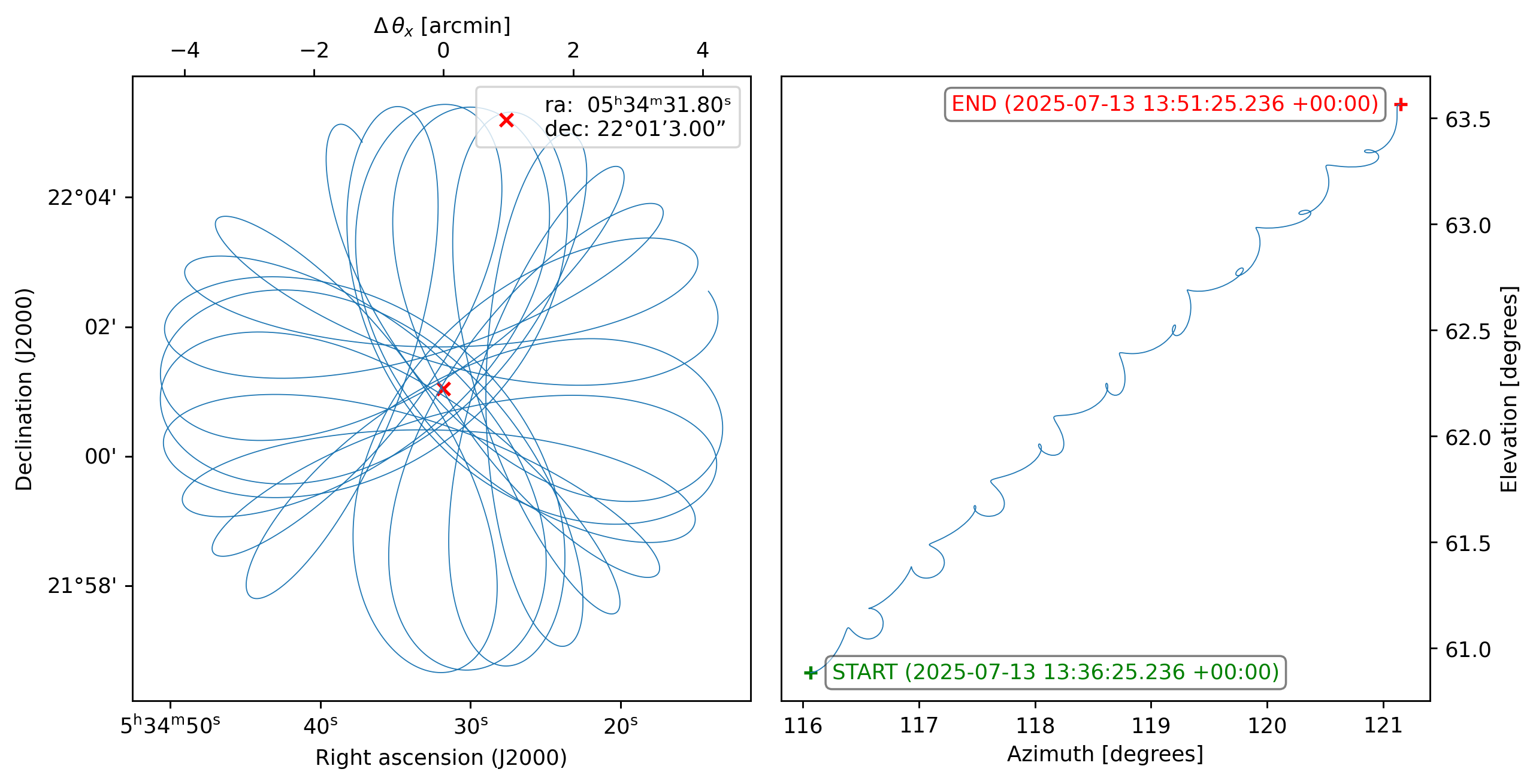Simulating observations with MUSTANG-2¶
MUSTANG-2 is a bolometric array on the Green Bank Telescope. In this notebook we simulate an observation of the Whirlpool Galaxy (M51).
[1]:
import maria
from maria.io import fetch
input_map = maria.map.load(fetch("maps/crab_nebula.fits"), nu=93e9)
input_map.plot()
print(input_map)
2025-11-21 01:57:49.631 INFO: Fetching https://github.com/thomaswmorris/maria-data/raw/master/maps/crab_nebula.fits
Downloading: 100%|████████████████| 2.00M/2.00M [00:00<00:00, 24.6MB/s]
ProjectedMap:
shape(nu, y, x): (1, 500, 500)
stokes: naive
nu: [93.] GHz
t: naive
z: naive
quantity: rayleigh_jeans_temperature
units: K_RJ
min: 0.000e+00
max: 5.876e-02
rms: 9.295e-03
center:
ra: 05ʰ34ᵐ31.80ˢ
dec: 22°01’3.00”
size(y, x): (8.83’, 8.83’)
resolution(y, x): (1.06”, 1.06”)
beam(maj, min, rot): [[0. 0. 0.]] rad
memory: 4 MB

[2]:
from maria import Planner
planner = Planner(target=input_map, site="green_bank", constraints={"el": (60, 90)})
plans = planner.generate_plans(total_duration=900, sample_rate=100)
plans[0].plot()
print(plans)
PlanList(1 plans, 900 s):
start_time duration target(ra,dec) center(az,el)
chunk
0 2025-11-21 04:57:50.814 +00:00 900 s (83.63°, 22.02°) (117.5°, 61.62°)

[3]:
instrument = maria.get_instrument("MUSTANG-2")
print(instrument)
instrument.plot()
Instrument(1 array)
├ arrays:
│ n FOV baseline bands polarized
│ array1 217 4.2’ 0 m [m2/f093] False
│
└ bands:
name center width η NEP NET_RJ NET_CMB FWHM
0 m2/f093 86.21 GHz 20.98 GHz 0.1 15 aW√s 0.5711 mK_RJ√s 0.6905 mK_CMB√s 9.133”

[4]:
sim = maria.Simulation(
instrument,
plans=plans,
site="green_bank",
map=input_map,
atmosphere="2d",
)
print(sim)
2025-11-21 01:57:58.745 INFO: Fetching https://github.com/thomaswmorris/maria-data/raw/master/atmosphere/spectra/am/v3/green_bank.h5
Downloading: 100%|████████████████| 22.0M/22.0M [00:00<00:00, 77.9MB/s]
2025-11-21 01:57:59.626 INFO: Fetching https://github.com/thomaswmorris/maria-data/raw/master/atmosphere/weather/era5/green_bank.h5
Downloading: 100%|████████████████| 12.0M/12.0M [00:00<00:00, 51.9MB/s]
Simulation
├ Instrument(1 array)
│ ├ arrays:
│ │ n FOV baseline bands polarized
│ │ array1 217 4.2’ 0 m [m2/f093] False
│ │
│ └ bands:
│ name center width η NEP NET_RJ NET_CMB FWHM
│ 0 m2/f093 86.21 GHz 20.98 GHz 0.1 15 aW√s 0.5711 mK_RJ√s 0.6905 mK_CMB√s 9.133”
├ Site:
│ region: green_bank
│ timezone: America/New_York
│ location:
│ longitude: 79°50’23.28” W
│ latitude: 38°25’59.16” N
│ altitude: 825 m
│ seasonal: True
│ diurnal: True
├ PlanList(1 plans, 900 s):
│ start_time duration target(ra,dec) center(az,el)
│ chunk
│ 0 2025-11-21 04:57:50.814 +00:00 900 s (83.63°, 22.02°) (117.5°, 61.62°)
├ '2d'
└ ProjectedMap:
shape(stokes, nu, y, x): (1, 1, 500, 500)
stokes: I
nu: [93.] GHz
t: naive
z: naive
quantity: rayleigh_jeans_temperature
units: K_RJ
min: 0.000e+00
max: 5.876e-02
rms: 9.295e-03
center:
ra: 05ʰ34ᵐ31.80ˢ
dec: 22°01’3.00”
size(y, x): (8.83’, 8.83’)
resolution(y, x): (1.06”, 1.06”)
beam(maj, min, rot): [[0. 0. 0.]] rad
memory: 4 MB
[5]:
tods = sim.run()
tods[0].plot()
2025-11-21 01:58:00.314 INFO: Simulating observation 1 of 1
Constructing atmosphere: 100%|████████████████| 8/8 [00:00<00:00, 8.74it/s]
Generating turbulence: 100%|████████████████| 8/8 [00:00<00:00, 22.35it/s]
Sampling turbulence: 100%|████████████████| 8/8 [00:03<00:00, 2.32it/s]
Computing atmospheric emission: 100%|████████████████| 1/1 [00:00<00:00, 1.06it/s, band=m2/f093]
Sampling map: 100%|████████████████| 1/1 [00:08<00:00, 8.48s/it, band=m2/f093, channel=(0 Hz, inf Hz), stokes=I]
Generating noise: 100%|████████████████| 1/1 [00:00<00:00, 1.05it/s, band=m2/f093]
2025-11-21 01:58:28.436 INFO: Simulated observation 1 of 1 in 28.11 s

[6]:
from maria.mappers import BinMapper
mapper = BinMapper(
center=input_map.center,
frame="ra/dec",
width=10 / 60,
height=10 / 60,
resolution=0.05 / 60,
tod_preprocessing={
"window": {"name": "hamming"},
"remove_modes": {"modes_to_remove": [0]},
"remove_spline": {"knot_spacing": 60, "remove_el_gradient": True},
},
map_postprocessing={
"gaussian_filter": {"sigma": 1},
"median_filter": {"size": 1},
},
units="uK_RJ",
tods=tods,
)
output_map = mapper.run()
2025-11-21 01:58:34.812 INFO: Inferring mapper stokes parameters 'I' for mapper.
Preprocessing TODs: 100%|████████████████| 1/1 [00:01<00:00, 1.52s/it]
Mapping band m2/f093: 100%|██████████| 1/1 [00:02<00:00, 2.99s/it, stokes=I, tod=1/1]
2025-11-21 01:58:39.365 INFO: Ran mapper for band m2/f093 in 2.998 s.
[7]:
output_map.plot()
output_map.to_fits("/tmp/simulated_mustang_map.fits")
